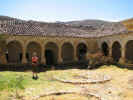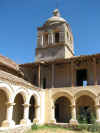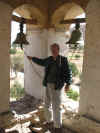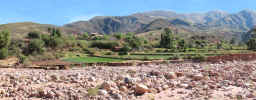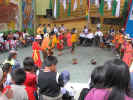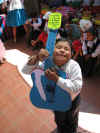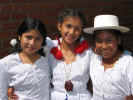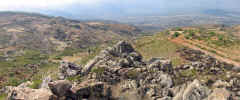welcome to worldwidewachs.com
OUR FOURTH TIME IN BOLIVIA!
Marvin writes:We arrived in Cochabamba on July 5, settled into “our” rooms at Lucy’s and felt at home almost immediately. It was good to be back after two years, and after a few hours I felt as if I had never left.
Cochabamba cityscape July 2007
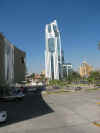
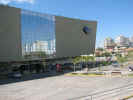 Cochabamba had changed little in the intervening two years. Some restaurants were gone, a Curves had opened and a 10-screen multiplex cinema had
opened in one of the most modern new buildings in Bolivia. There had been devastating floods during the rainy season, quite unusual
I was told, but aside from a little more volume in the river through town, the area seemed as dry as always. There are two lakes in the Cochabamba valley
where I would have expected floodwaters to accumulate, but when we visited them in the course of our stay, both
exhibited the wide shorelines I remember from previous visits. Can you imagine how much fun the Corps of Engineers could have here?
Cochabamba had changed little in the intervening two years. Some restaurants were gone, a Curves had opened and a 10-screen multiplex cinema had
opened in one of the most modern new buildings in Bolivia. There had been devastating floods during the rainy season, quite unusual
I was told, but aside from a little more volume in the river through town, the area seemed as dry as always. There are two lakes in the Cochabamba valley
where I would have expected floodwaters to accumulate, but when we visited them in the course of our stay, both
exhibited the wide shorelines I remember from previous visits. Can you imagine how much fun the Corps of Engineers could have here?
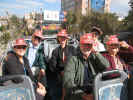 The first Amizade work group was scheduled for just a week after our arrival. This group had been dubbed the “Wachs Family and Friends Group” because
we had invited Martie’s two sisters, Shirley and Anne, and a couple we had met in Nicaragua on an El Porvenir work group, Bob and Peg, to join us. Bob
and Peg are an energetic couple approaching their 80s, who still hope to see it all. At the rate they still travel, they have a good chance. For years
we have wanted Shirley and Anne to share more than our stories and slides of Bolivia. We began with a new addition to tourism in Cochabamba: a
double-decker bus city tour! For Martie and me, the novelty was being at a height that allowed us to see over the walls. At street level one can only
speculate on the hidden house.
The first Amizade work group was scheduled for just a week after our arrival. This group had been dubbed the “Wachs Family and Friends Group” because
we had invited Martie’s two sisters, Shirley and Anne, and a couple we had met in Nicaragua on an El Porvenir work group, Bob and Peg, to join us. Bob
and Peg are an energetic couple approaching their 80s, who still hope to see it all. At the rate they still travel, they have a good chance. For years
we have wanted Shirley and Anne to share more than our stories and slides of Bolivia. We began with a new addition to tourism in Cochabamba: a
double-decker bus city tour! For Martie and me, the novelty was being at a height that allowed us to see over the walls. At street level one can only
speculate on the hidden house.
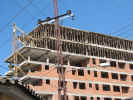
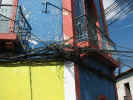
New construction Existing electric system
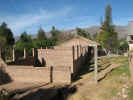 As in previous years we stayed at the Casa de Retiros in Vinto, a town some 30 minutes outside of Cochabamba. From there we commuted daily into the campo
(countryside) to work at the Viloma School. Over a period of two weeks we sanded and painted window frames and doors, did electrical work, and stuccoed. One
of my first jobs was to repair a chipped floor tile. This was done very carefully with a cold chisel and mallet. As I was about to knock out the last few
inches, a crack suddenly ran across the grout and into the adjoining tile. Oops! With the second tile, I took little bites, very carefully orienting the
chisel for each blow. Yep, did it again! Delivered a brief lecture in Anglo Saxon expletives, and began removing the third tile. You know the gods are not
on your side when, after painstakingly, over an excruciatingly long time, you remove the last half square centimeter of grout only to have it pull the
glaze off the edge of the 4th tile. Felix, the head mason, having spotted a trend in my work, diplomatically suggested that we could cover
that with grout and be done with it.
As in previous years we stayed at the Casa de Retiros in Vinto, a town some 30 minutes outside of Cochabamba. From there we commuted daily into the campo
(countryside) to work at the Viloma School. Over a period of two weeks we sanded and painted window frames and doors, did electrical work, and stuccoed. One
of my first jobs was to repair a chipped floor tile. This was done very carefully with a cold chisel and mallet. As I was about to knock out the last few
inches, a crack suddenly ran across the grout and into the adjoining tile. Oops! With the second tile, I took little bites, very carefully orienting the
chisel for each blow. Yep, did it again! Delivered a brief lecture in Anglo Saxon expletives, and began removing the third tile. You know the gods are not
on your side when, after painstakingly, over an excruciatingly long time, you remove the last half square centimeter of grout only to have it pull the
glaze off the edge of the 4th tile. Felix, the head mason, having spotted a trend in my work, diplomatically suggested that we could cover
that with grout and be done with it.
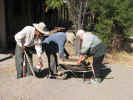 Bob and Peg initially screened sand. Typically, sand is delivered by the truckfull directly from the riverbed. If the consumer wants fine sand for stucco,
he must sift it himself. Bob and Peg did this by having one of them hold a wooden frame with “screen door wire” attached to it, while the other shoveled
the gravel/sand into the frame. Over the two weeks, they also applied some sort of spackling over hairline cracks that appeared in the prior group’s stucco.
This was in preparation for painting the classroom walls. They also did a great job sanding and staining the wooden window frames as well.
Bob and Peg initially screened sand. Typically, sand is delivered by the truckfull directly from the riverbed. If the consumer wants fine sand for stucco,
he must sift it himself. Bob and Peg did this by having one of them hold a wooden frame with “screen door wire” attached to it, while the other shoveled
the gravel/sand into the frame. Over the two weeks, they also applied some sort of spackling over hairline cracks that appeared in the prior group’s stucco.
This was in preparation for painting the classroom walls. They also did a great job sanding and staining the wooden window frames as well.
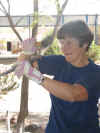
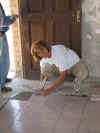 Meanwhile, Martie’s sisters dedicated themselves to stuccoing. Prior to
Meanwhile, Martie’s sisters dedicated themselves to stuccoing. Prior to
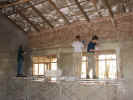 applying stucco, any cast concrete surface must be prepared so that it will
hold the coating. In Bolivian construction, this is accomplished by putting a one-inch dimple in the smooth surface by chipping it out with a "punto"
(pointed chisel), and "mateo" (mallet).There must be hundreds of these divots in a 20-foot bond beam .After a few days, the actual stuccoing began.
I admit that I don’t have the knack or the patience for stucco, but the Robertson genes must carry a stucco dominant. All three sisters are very good at it.
applying stucco, any cast concrete surface must be prepared so that it will
hold the coating. In Bolivian construction, this is accomplished by putting a one-inch dimple in the smooth surface by chipping it out with a "punto"
(pointed chisel), and "mateo" (mallet).There must be hundreds of these divots in a 20-foot bond beam .After a few days, the actual stuccoing began.
I admit that I don’t have the knack or the patience for stucco, but the Robertson genes must carry a stucco dominant. All three sisters are very good at it.
There is another cultural difference in construction that leads to what we (in the U.S.) would look on as inefficient. Buildings are built with little or no planning for installing electricity or plumbing. When these artisans are called in, they must chisel holes and run conduit in solid brick or concrete walls. In a country where construction loans are unheard of, construction begins when you have extra cash. In a country like Bolivia, steady employment and a stable economic system are not the norm.So first order of business is to get a roof over your head. Every boliviano (local currency) is dedicated to bricks and concrete. Rarely is there enough money in the initial stages to rough in plumbing or electrical conduit. In a few more years when you have saved another little pile, the plumber or electrician can be hired. Meanwhile, there is a roof over the family.
With this background information, I was able to more easily accept my next task – putting conduit and electrical boxes in the classroom walls. First, I had to chisel a hole through a foot-thick brick wall covered with stucco to join my conduit to the circuit in the next room. Then following a chalk line, I chiseled a trench through the stucco and into the brick below, deep enough to hold a ½” conduit. The holes for the plug and switch boxes had to be another 1½” deep. After several days of this, I was Punto Pro, ready to take on John Henry. Joining lengths of conduit is as simple as it is practical. Heat one end of the plastic tube with a twist of burning paper. When the end softens and before it sags, blackens or catches fire, spread the opening and insert the connecting piece of conduit.Voila! Instant bell and socket – no glue required. The last step uses stucco to patch up the wall, smoothing everything with a piece of Styrofoam to match the existing stucco.
Amizade groups work in an atmosphere that is relaxed and jovial. When you get tired or thirsty you take a break. If this task is not to your liking, somebody will trade, or Felix will find something else for you. Heck, we have even been known to kid around a little. And at the end of the day as you trudge, tired and dirty to the trufi, our twelve-passenger van, you can look back and say, “Look what I/we did today.” That’s why I do this.That’s my paycheck.
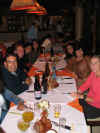 Like all good laborers, we look forward to the weekend. We returned to town on Friday, visiting CEOLI, the center for disabled children. We wanted the
CEOLI people to meet Martie’s sisters, as well as let Shirley and Anne get a feel for the place. Then we went to Millenium, an organization new to us,
but one that for years has been on Amizade’s list of places for long term volunteers to work. We found out that Millenium’s purview covers a lot. They run
an orphanage for abandoned children, ages 0-5, arranging adoptions mostly into Europe. (We were told that Bolivia and the U.S. do not
have an adoption treaty, so none of these kids can come to the States.) Cochabamba currently averages 4 abandoned babies a day – abandoned in
hospitals, garbage dumps or on the streets. This is up from just 1 a day, several years ago, and appears to be due to the worsening economic conditions.
Like all good laborers, we look forward to the weekend. We returned to town on Friday, visiting CEOLI, the center for disabled children. We wanted the
CEOLI people to meet Martie’s sisters, as well as let Shirley and Anne get a feel for the place. Then we went to Millenium, an organization new to us,
but one that for years has been on Amizade’s list of places for long term volunteers to work. We found out that Millenium’s purview covers a lot. They run
an orphanage for abandoned children, ages 0-5, arranging adoptions mostly into Europe. (We were told that Bolivia and the U.S. do not
have an adoption treaty, so none of these kids can come to the States.) Cochabamba currently averages 4 abandoned babies a day – abandoned in
hospitals, garbage dumps or on the streets. This is up from just 1 a day, several years ago, and appears to be due to the worsening economic conditions.
Millenium also has a therapy clinic for children in need of special exercise regimens. They provide family counseling for families who have abandoned or placed their children under state care, and who have changed their minds and now want to get their children back. This counseling is designed to provide some training/education, as well as economic help, in the hopes that the child is not returned to the same conditions that precipitated the original abandonment. We learned that Millenium is supported in part by a Bolivian living in the U.S., and is currently establishing a 501(c)(3) to enable them to raise money in the U.S.
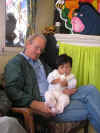 On this particular occasion, we visited the Millenium orphanage, where Peg and Bob passed out a zillion Beanie Babies that they had brought. Peg
also gave the orphanage 40 or more colorful sets of shorts and tops donated by a U.S. retailer. I got to feed a child his bottle while the older kids
enjoyed their morning snacks. Other volunteers fed the children, held them or played with them.A little while later we trouped into the courtyard to play
ball, ride trikes and swing.
On this particular occasion, we visited the Millenium orphanage, where Peg and Bob passed out a zillion Beanie Babies that they had brought. Peg
also gave the orphanage 40 or more colorful sets of shorts and tops donated by a U.S. retailer. I got to feed a child his bottle while the older kids
enjoyed their morning snacks. Other volunteers fed the children, held them or played with them.A little while later we trouped into the courtyard to play
ball, ride trikes and swing.
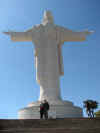 Saturday was our free day. We took taxis up to the Cristo, a drive up a winding narrow road
that Shirley declared her scariest ride ever. No matter how many times I go there, I still enjoy the view. Someday I will find it sunny with unlimited
visibility.Nor do I ever tire of telling the story of how it is now the world’s tallest statue of Christ (40.44 met
Saturday was our free day. We took taxis up to the Cristo, a drive up a winding narrow road
that Shirley declared her scariest ride ever. No matter how many times I go there, I still enjoy the view. Someday I will find it sunny with unlimited
visibility.Nor do I ever tire of telling the story of how it is now the world’s tallest statue of Christ (40.44 met
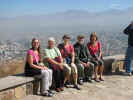 ers including the 6.24 meters
pedestal and 32.87 meters between finger tips). The short version is that contractually, the statue could be no higher than Rio de Janeiro’s. The body
was measured to be the right height and, as measured just prior to being lifted into place, so was the head. But
what was not noticed until it was too late was that the Bolivian masons made the neck a meter longer than specified. Throughout
its history, Bolivia usually ends up on the short end, but in this case it did get the best of its neighbor, Brazil, by about three feet.
ers including the 6.24 meters
pedestal and 32.87 meters between finger tips). The short version is that contractually, the statue could be no higher than Rio de Janeiro’s. The body
was measured to be the right height and, as measured just prior to being lifted into place, so was the head. But
what was not noticed until it was too late was that the Bolivian masons made the neck a meter longer than specified. Throughout
its history, Bolivia usually ends up on the short end, but in this case it did get the best of its neighbor, Brazil, by about three feet.
Saturday afternoon, we went out to Felix’ village in the outskirts of Cochabamba (near the Complejo del Carmen)
for a parade. Our 7-year-old godchild Milton, Felix’s youngest son,
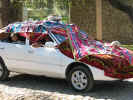 was marching/dancing in his first parade. Felix
was marching/dancing in his first parade. Felix
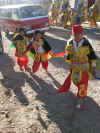 thought it would start about 2:00 pm. Using our best estimate of Bolivian scheduling, we got there
after 3:00 pm and wandered down the cobblestone street toward the music. Here and there costumed kids and their families were walking toward the staging
area. But nothing was happening. We had arrived in plenty of time. We appropriated a rock wall in the shade and settled down to wait. After a while Isabel,
Felix’s wife, came along. Then a few minutes later, came Felix. And somewhere around 4:00 to 4:30 the parade came by – right on time for Bolivia.
After some post parade socializing with our compadres, the group took off to town for much
needed showers and a delicious repast at a new restaurant called Paprika.
thought it would start about 2:00 pm. Using our best estimate of Bolivian scheduling, we got there
after 3:00 pm and wandered down the cobblestone street toward the music. Here and there costumed kids and their families were walking toward the staging
area. But nothing was happening. We had arrived in plenty of time. We appropriated a rock wall in the shade and settled down to wait. After a while Isabel,
Felix’s wife, came along. Then a few minutes later, came Felix. And somewhere around 4:00 to 4:30 the parade came by – right on time for Bolivia.
After some post parade socializing with our compadres, the group took off to town for much
needed showers and a delicious repast at a new restaurant called Paprika.
Sunday, Jean Carla, the director of Amizade in Bolivia, and Raul, our trufi driver, took us all on a tour of several small historical towns surrounding Cochabamba. We visited Puñata, Tarata, Arani and Cliza. The church in Puñata and the convent nearby are both UNESCO heritage sites.The church was built in 1740 and is mostly restored.The convent was built in 1579, was still being used in the 1990s, and is just now being restored
Puñata Convent Convent Bell tower Old bat in belfry
Our second week of work was much like the first, except the kids were back in school after a “winter break”.Martie and Shirley read Spanish versions of children’s stories to several of the primary classes. Shirley read The Hungry Caterpillar, and Martie read If You Give a Pig a Pancake. We also attracted groups of gawkers any time there was a break in classes. Watching gringos is really interesting. Javier was one of the first to show up (Bolivia 2005). In 2005 a member of our group named Carl befriended first grader Javier, usually sharing some candy with him each day.So I teasingly emailed Carl to tell him that Javier had miraculously recovered from his diabetic coma, upon learning we were back.
The week finished with a goodbye ceremony put on by the Viloma School students, complete with poetry recitation and native dancing. After our return to Cochabamba the group did last minute souvenir shopping and attended a farewell dinner with the masons and their families. After everyone was seen safely airborne, Martie and I had a week to rest up before the next group arrived.
Dry river bed near Raul's house
The next work session would be the big 10th Anniversary Group. Jean Carla had been preparing for months. Not only would the original founder of Amizade and the current director of Amizade be in attendance, but also former volunteers and family members. It was to be a Bolivian style celebration of Amizade’s ten years’ presence in Cochabamba.
But for this “rest” week before the Anniversary group we met with the staff at CEOLI to catch up on the last two years, as well as bring Healing the Children (www.htcmo.org) to their attention. We also went to the home of Daniela, the CEOLI card art teacher, to help assemble and package CEOLI cards. We experienced first hand how much work it takes to prepare cards for the artists to paint, not to mention all the gluing and packaging after the artists are done.(See these beautiful cards, painted by disabled Bolivian artists, by clicking on “CEOLI cards” button on the menu above.)
We had been drawing out cash from a local ATM to pay for all of the cards we had sent home with Bob, Peg, Shirley and Anne. Because of withdrawal limits, this required numerous trips. On my last trip, the machine ate my card. Despite a kick in the shin, a number of poundings to its mechanisms and a complete recitation of its unsavory genealogy, the ATM was unmoved. No card. No explanation.¡Nada! Another Bolivian adventure begins.
After being assured on our first trip to the ATM vendor that my card would be returned “next week” when the machine was serviced, I learned on my second trip that human ingenuity has produced a device that thieves insert in an ATM slot.You insert your card, then your PIN, and then nothing. After you leave in frustration, the thief pulls the reader and now has your card and PIN.I was lucky. I had monitored my account over the Internet, so I knew there was no activity, and as the reader had never asked for my PIN, the card was useless to the thief. An email to my bank put an end to this saga, but I was without an ATM card for the duration. I was told that sometimes the readers spit out the card after awhile, so perhaps patience will pay off better than a tirade. And that sweet but impatient lady waiting for you to finish may just be waiting to retrieve your card.
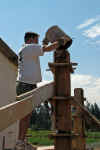
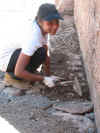 The Anniversary Group was an eclectic group of travelers, although it was one college student’s first trip abroad without her parents. Sowdhámani,
a Pre-med college student, was having a wonderful time; but her dad, back in the states, was a bit anxious about her choice of vacations. Brad and Ed
were veteran travelers, new to Bolivia, but not to service programs. Dan was the Amizade founder and brought his fiancée Gily, an Amizade in-country
director for Brazil (like Jean Carla is for Bolivia). Dan’s mother, Betty Lou, was along, but I am unclear whether it was because she is a
doting mother, or it was the only way she can get quality time with her peripatetic offspring. Ben, like us, was a returning long term volunteer to
Bolivia.Due to schedule conflicts, Mike, the U.S. Amizade
Director, did not show up until the second week. They were a great group to work with.
The Anniversary Group was an eclectic group of travelers, although it was one college student’s first trip abroad without her parents. Sowdhámani,
a Pre-med college student, was having a wonderful time; but her dad, back in the states, was a bit anxious about her choice of vacations. Brad and Ed
were veteran travelers, new to Bolivia, but not to service programs. Dan was the Amizade founder and brought his fiancée Gily, an Amizade in-country
director for Brazil (like Jean Carla is for Bolivia). Dan’s mother, Betty Lou, was along, but I am unclear whether it was because she is a
doting mother, or it was the only way she can get quality time with her peripatetic offspring. Ben, like us, was a returning long term volunteer to
Bolivia.Due to schedule conflicts, Mike, the U.S. Amizade
Director, did not show up until the second week. They were a great group to work with.
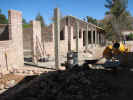
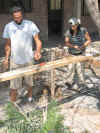 So, during the next two weeks, we tied lots of rebar, and poured cement floors in three classrooms, as well as a
few porch posts, and near the end poured the footers for the last classroom. Martie and I also learned a lot about the early years of Amizade, as well
as the trials and tribulations of operating an NGO, while chatting with Dan and Mike. On the minus side, Ben contracted a super sized bout of
stomach
So, during the next two weeks, we tied lots of rebar, and poured cement floors in three classrooms, as well as a
few porch posts, and near the end poured the footers for the last classroom. Martie and I also learned a lot about the early years of Amizade, as well
as the trials and tribulations of operating an NGO, while chatting with Dan and Mike. On the minus side, Ben contracted a super sized bout of
stomach
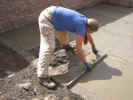 flu and ended up in the hospital for some re-hydration therapy. (You can get good care in a private hospital in Bolivia and actually
afford it. The all-inclusive, per diem cost is more like a night at the Holiday Inn, rather than the Presidential Suite at the Waldorf.) Martie and
Brad got to visit the doctor as well: she for an infected spider bite, and he for an eye scratch, his patch getting him Pirate for a Day honors.
Even I couldn’t seem to stay away from the band-aid box for long this session.
flu and ended up in the hospital for some re-hydration therapy. (You can get good care in a private hospital in Bolivia and actually
afford it. The all-inclusive, per diem cost is more like a night at the Holiday Inn, rather than the Presidential Suite at the Waldorf.) Martie and
Brad got to visit the doctor as well: she for an infected spider bite, and he for an eye scratch, his patch getting him Pirate for a Day honors.
Even I couldn’t seem to stay away from the band-aid box for long this session.
Our weekend left everybody on their own on Saturday, which suited the veterans. They had things to do, old friends to visit and places to go.
We got back together on Sunday to take
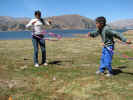 a small private tour bus to the
Trout Farm. En route, we again passed all the scenery described in previous journals when our destination was Incachaca. Since we were not going
all the way to Incachaca, we took time to visit Lake Corani, a huge lake just glimpsed in passing before. As they had in the past, Felix and his family
had joined us. When we got out at the lake to stretch our legs, not only did we get to enjoy the vista, but were also entertained when Gily tried to
teach Milton how to Hula-Hoop. We arrived at the Trout Farm a couple of hours later. After strolling the grounds at the Trout Farm, ogling all the lush
tropical vegetation and inspecting the cascading trout ponds, we returned to the outdoor restaurant and ordered fresh … uh, what was that fish?
a small private tour bus to the
Trout Farm. En route, we again passed all the scenery described in previous journals when our destination was Incachaca. Since we were not going
all the way to Incachaca, we took time to visit Lake Corani, a huge lake just glimpsed in passing before. As they had in the past, Felix and his family
had joined us. When we got out at the lake to stretch our legs, not only did we get to enjoy the vista, but were also entertained when Gily tried to
teach Milton how to Hula-Hoop. We arrived at the Trout Farm a couple of hours later. After strolling the grounds at the Trout Farm, ogling all the lush
tropical vegetation and inspecting the cascading trout ponds, we returned to the outdoor restaurant and ordered fresh … uh, what was that fish?
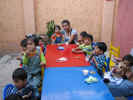 Our last weekend with the Anniversary group was a string of celebrations. The first one was at CEOLI, where the kids entertained us
with songs and dancing. Some speech making and plaque presenting followed. Then we went to Millenium for yogurt and empanadas with the little ones.
Ben wore a rented a Barney costume to entertain the kids, however, their unfamiliarity with the character led to some initial scariness. But yogurt and
empanadas trumps a purple monster every time.
Our last weekend with the Anniversary group was a string of celebrations. The first one was at CEOLI, where the kids entertained us
with songs and dancing. Some speech making and plaque presenting followed. Then we went to Millenium for yogurt and empanadas with the little ones.
Ben wore a rented a Barney costume to entertain the kids, however, their unfamiliarity with the character led to some initial scariness. But yogurt and
empanadas trumps a purple monster every time.
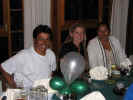
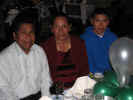 The Tenth Anniversary Fiesta was a crowning success. Jean Carla had pulled out all the stops. She reserved a hall at a fine restaurant where we had an
excellent catered dinner followed by a DJ playing dance music until the wee hours. The local newspaper covered the event for the society page. Every group who had been helped or had worked alongside Amizade had
representatives in attendance. Again, speeches, plaques and mutual appreciation abounded. I had a great time. I did not leave with the first wave of
adults around 11:00 pm, nor did I move on to the city nightclubs with the younger contingent when the restaurant and DJ closed down, but I did party hearty until 1:30 or so.
The Tenth Anniversary Fiesta was a crowning success. Jean Carla had pulled out all the stops. She reserved a hall at a fine restaurant where we had an
excellent catered dinner followed by a DJ playing dance music until the wee hours. The local newspaper covered the event for the society page. Every group who had been helped or had worked alongside Amizade had
representatives in attendance. Again, speeches, plaques and mutual appreciation abounded. I had a great time. I did not leave with the first wave of
adults around 11:00 pm, nor did I move on to the city nightclubs with the younger contingent when the restaurant and DJ closed down, but I did party hearty until 1:30 or so.
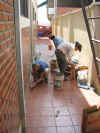
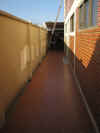 After the Anniversary group left Bolivia, Martie and I still had lots to do, and just over 3 weeks to accomplish it. We had agreed to tile three
walkways at CEOLI that did not get done during the Telemarathon expansion in 2004. We worked mornings at CEOLI with Felix and his brother, Juan, laying
tile. As school was in session we had to contend with kids and teachers needing to pass through the work area on the way to their classrooms. We also had
many “Sidewalk Superintendents”. Hardly an hour went by without someone saying “Muy bonito”. We did a walkway each week, and despite our imperfections,
the tiling did turn out “very beautiful”.
After the Anniversary group left Bolivia, Martie and I still had lots to do, and just over 3 weeks to accomplish it. We had agreed to tile three
walkways at CEOLI that did not get done during the Telemarathon expansion in 2004. We worked mornings at CEOLI with Felix and his brother, Juan, laying
tile. As school was in session we had to contend with kids and teachers needing to pass through the work area on the way to their classrooms. We also had
many “Sidewalk Superintendents”. Hardly an hour went by without someone saying “Muy bonito”. We did a walkway each week, and despite our imperfections,
the tiling did turn out “very beautiful”.
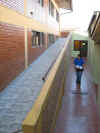
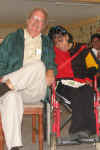 During this period, we also worked on the CEOLI card project. We collected short biographies and pictures of the new and apprentice artists, as
well as updating the veterans’ data and pictures. We helped Daniela with stencil tracing the cards and gathering up the
remaining cards we would take home. (In each work group some volunteers “mule” a shoebox or two of cards back to the U.S. for us.) We also tweaked the
CEOLI card business plan. We were able to resolve two problems with one solution. The first problem was that there is a spring trade show in Cochabamba
where the artists could display and sell cards, but they were not able to buy supplies to make more than a few dozen cards. The second problem was one of
our making: we paid for the cards when they shipped, maybe two or three times a year. This meant the artists got a lot of money at one time, rather than
when they needed it. So, starting in February 2008 with our annual order, we will pay each month. That way if we pay evenly over six months, CEOLI can
budget materials and pay the artists each time they turn in their work. Each year one of our artists asks, “How long are you going to sell our
cards?” “As long as we can, maybe longer”, we answer.
During this period, we also worked on the CEOLI card project. We collected short biographies and pictures of the new and apprentice artists, as
well as updating the veterans’ data and pictures. We helped Daniela with stencil tracing the cards and gathering up the
remaining cards we would take home. (In each work group some volunteers “mule” a shoebox or two of cards back to the U.S. for us.) We also tweaked the
CEOLI card business plan. We were able to resolve two problems with one solution. The first problem was that there is a spring trade show in Cochabamba
where the artists could display and sell cards, but they were not able to buy supplies to make more than a few dozen cards. The second problem was one of
our making: we paid for the cards when they shipped, maybe two or three times a year. This meant the artists got a lot of money at one time, rather than
when they needed it. So, starting in February 2008 with our annual order, we will pay each month. That way if we pay evenly over six months, CEOLI can
budget materials and pay the artists each time they turn in their work. Each year one of our artists asks, “How long are you going to sell our
cards?” “As long as we can, maybe longer”, we answer.
CEOLI dancers Budding guitarist Fatima (center) and friends
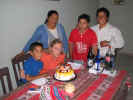 August 23 was Martie’s birthday. At CEOLI the kids all sang Feliz Cumpleanos to Martie, and then served saltenas, cake and coke.
After siesta time, we went to Felix and Isabel’s for a birthday party. They outdid themselves. There was oca (a tasty fingerling sweet potato),
two kinds of white potatoes, tomatoes, avocado, veggies, and chicken (even a soy burger for the birthday girl). For dessert they served a
huge store-bought cake. Each family member wished her Happy Birthday while spreading confetti in her hair for good luck. She got a bottle of wine
(which didn’t make it home), an intricately carved wooden box and a colorfully designed woolen blanket. These blankets are the Andean wheelbarrow – everything
that can be loaded on one’s back is carried in such blankets. Isabel gave Martie lessons, so she would be able to properly swaddle our grandson and
carry him around in true South American fashion (and in all likelihood, over his mother’s dead body!).
August 23 was Martie’s birthday. At CEOLI the kids all sang Feliz Cumpleanos to Martie, and then served saltenas, cake and coke.
After siesta time, we went to Felix and Isabel’s for a birthday party. They outdid themselves. There was oca (a tasty fingerling sweet potato),
two kinds of white potatoes, tomatoes, avocado, veggies, and chicken (even a soy burger for the birthday girl). For dessert they served a
huge store-bought cake. Each family member wished her Happy Birthday while spreading confetti in her hair for good luck. She got a bottle of wine
(which didn’t make it home), an intricately carved wooden box and a colorfully designed woolen blanket. These blankets are the Andean wheelbarrow – everything
that can be loaded on one’s back is carried in such blankets. Isabel gave Martie lessons, so she would be able to properly swaddle our grandson and
carry him around in true South American fashion (and in all likelihood, over his mother’s dead body!).
Our work at CEOLI was counterbalanced by our social life in Cochabamba. Sometimes it feels like we have more social life there than in Joplin. This trip we became friends with Erika and David. Erika is Jean Carla’s new assistant, and David is a local architect, not to mention Erika’s fiancé. Both young people are dedicated to their work and do not wish to become part of the intelligentsia exodus that is plaguing Bolivia these days. We were honored when they invited us to dine with their families one evening. Being invited into a Bolivian family home is an honor we do not take lightly.
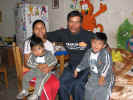 At various times, we went to our other godchild, Orlando’s house for a birthday party, or took his family to
Globos, a popular sandwich and ice cream restaurant – a kind of Applebee’s and Baskin Robbins combination. We
also met Felix, Juan and their families there upon occasion.
At various times, we went to our other godchild, Orlando’s house for a birthday party, or took his family to
Globos, a popular sandwich and ice cream restaurant – a kind of Applebee’s and Baskin Robbins combination. We
also met Felix, Juan and their families there upon occasion.
Bolivian politics can be incomprehensible to an outsider. It could be described as bouts of passionate turmoil followed by business as usual. One is left with an impression that some group is demonstrating in the streets about their particular grievance somewhere in Bolivia every day. What is incomprehensible is that despite all these demonstrations nothing seems to change. While we were there, the city service workers had a one-day strike to protest no paychecks for the last three months. There was a bread strike in July to protest the rising cost of wheat. There were “vigilias” in Sucre for weeks, and some miners came to town to demonstrate for God only knows what. Even the cooks at CEOLI went on strike one day to protest some perceived harsh words by CEOLI’s director. Toward the end of August we had a “Paro Civico”. In the pecking order of strikes, this is supposed to be the top dog. It is the strongest strike / civil disobedience / protest against a particular policy where all businesses shut down. Although there are plenty of reasons to be upset with various policies of the Evo Morales presidency, the unique feature of this Paro Civico was that no one had a clear cut understanding of what they were protesting. Government policy? The judicial system? States rights? So everything was closed for the day. Protesters headed downtown. We stayed home. We got news that there were some hot heads on the Quillacollo Bridge, but the police were there to keep order. In the lowlands city of Santa Cruz there was a bit more violence. Mid afternoon we ventured out. Minimal traffic. The plazuela at the intersection of Avenidas Santa Cruz and America was blocked off with stones, but nobody was there. Globos was open, so we ate ice cream (pie de limón is a highly recommended flavor) and went home. The next day, life was back to normal, and nothing changed- so what was the purpose of it all?
In contrast, the following week was Dia de los Peatones (Day of Pedestrians). All day cars/buses/taxis are prohibited from using the streets, in a symbolic gesture to the environment. We awoke that Sunday to a similar silence experienced during the Paro.Upon venturing out, the mood was appropriately more festive. Families strolled the streets, and never except in China have I seen so many bicycles. What a great idea! We, the U.S., should follow the Bolivian example. We wandered downtown, strolling some of the tree-lined main streets, threading our way through a festive crowds of people, kiosks with food and drink. Everyone was out, enjoying a relaxing walk and visits with friends.
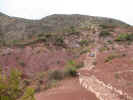
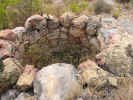 Our last big adventure was one we had toyed with on several previous trips. Outside
of Cochabamba, just past Vinto, in the mountains above the small town of Sipe
Sipe is an Inca ruin called Inkarakay. We had gotten more information from David’s father, who is
the director of the anthropology museum in Cochabamba, not only information
about Inkarakay, but also about the Inca presence throughout the Cochabamba
valley. We arranged for one of his
students to guide Erika, Martie and me up the Inca Trail to visit the ruins. A taxi dropped us off where the trail crossed the road, and we hiked the 5 – 6
Our last big adventure was one we had toyed with on several previous trips. Outside
of Cochabamba, just past Vinto, in the mountains above the small town of Sipe
Sipe is an Inca ruin called Inkarakay. We had gotten more information from David’s father, who is
the director of the anthropology museum in Cochabamba, not only information
about Inkarakay, but also about the Inca presence throughout the Cochabamba
valley. We arranged for one of his
students to guide Erika, Martie and me up the Inca Trail to visit the ruins. A taxi dropped us off where the trail crossed the road, and we hiked the 5 – 6
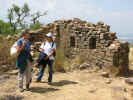
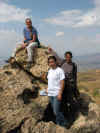 kilometers to the top in a little over 3 hours. We stopped often to admire the view, listen to our guide wax poetic about
the Incas and, oh yes, to catch our breath. (We were hiking at an altitude of about 8500 – 9000 feet.) We had lunch at the ruins, checked out remaining
structures (Inkarakay was a sentry post/fort to protect the several hundred grain storage silos in the
valley from lowland tribes raiding from the east), and went to a pinnacle overlooking the ruins. This
“altar” is used in present day ceremonies to welcome the return of the sun
on the winter solstice (June 21 in the southern hemisphere). The trek down was accomplished in about 2 hours, and we were home by
suppertime to finish packing for our return to the U.S.
kilometers to the top in a little over 3 hours. We stopped often to admire the view, listen to our guide wax poetic about
the Incas and, oh yes, to catch our breath. (We were hiking at an altitude of about 8500 – 9000 feet.) We had lunch at the ruins, checked out remaining
structures (Inkarakay was a sentry post/fort to protect the several hundred grain storage silos in the
valley from lowland tribes raiding from the east), and went to a pinnacle overlooking the ruins. This
“altar” is used in present day ceremonies to welcome the return of the sun
on the winter solstice (June 21 in the southern hemisphere). The trek down was accomplished in about 2 hours, and we were home by
suppertime to finish packing for our return to the U.S.
Panoramic view of Inkarakay with Sipe Sipe behind
At the completion of this trip, we have lived in Cochabamba slightly over a year, cumulatively. We have accomplished one of our objectives upon
retirement – we have lived outside the
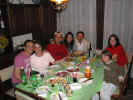 comforts of our own world long enough to be comfortable in a
foreign environment. When I walk through the door at Lucy’s house, I feel many of the things I feel walking into my own house. I am
comfortable. I am home. As we write these journals, we report on what we have done, with whom we
have interacted, and how we feel about the experience. Often we report that which is new, that which expresses cultural
differences, those things we feel are entertaining. But as time passes, the exotic becomes mundane, the unusual becomes usual
and the routine becomes, well, routine. Do not misinterpret this as a bad thing. Just
as I enthusiastically got up for 25 years to do engineering things in Joplin, I
get up enthusiastically to do volunteer things in Bolivia. What I am trying to say is that the excitement experience in a two-week
trip to see a foreign country gives way to a different experience – the
excitement of being part of a foreign country. It is quite rewarding to be comfortable as a long-term volunteer.
comforts of our own world long enough to be comfortable in a
foreign environment. When I walk through the door at Lucy’s house, I feel many of the things I feel walking into my own house. I am
comfortable. I am home. As we write these journals, we report on what we have done, with whom we
have interacted, and how we feel about the experience. Often we report that which is new, that which expresses cultural
differences, those things we feel are entertaining. But as time passes, the exotic becomes mundane, the unusual becomes usual
and the routine becomes, well, routine. Do not misinterpret this as a bad thing. Just
as I enthusiastically got up for 25 years to do engineering things in Joplin, I
get up enthusiastically to do volunteer things in Bolivia. What I am trying to say is that the excitement experience in a two-week
trip to see a foreign country gives way to a different experience – the
excitement of being part of a foreign country. It is quite rewarding to be comfortable as a long-term volunteer.
As we are committed to Bolivia over the long term and plan to return in 2009 or 2010, this journal is “to be continued.”

